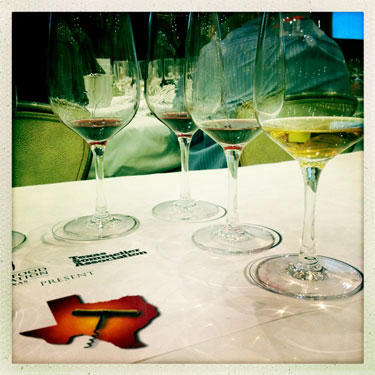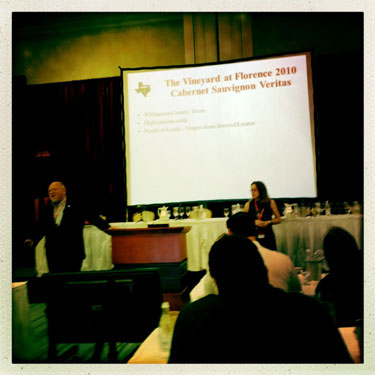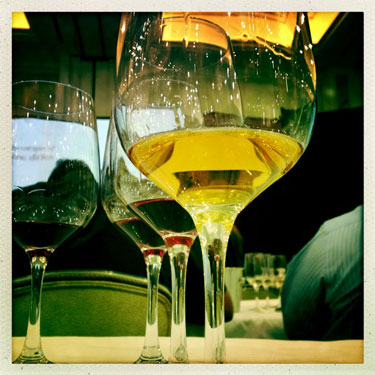Texsom 2012: What a Tasting Opportunity… From Margaux to Mason County Texas
The Sunday morning session began with a rush of servers, Sommeliers of all types with varying degrees of certification, pouring to over a hundred attendees, giving each eight glasses of dark red-purple wine from the French Bordeaux region. Representing wines included the complete Bordeaux experience: simple Haut-Medoc to well-structured Margaux to a well-aged and graceful Chateau Cos D’Estournel. Wayne Bending MS and Brett Zimmerman MS painted the picture of this well regarded wine region as being defined by water (or its removal from the Bordeaux swamps by the Dutch in the 1600’s) and the best winegrowing properties defined by piles of stones brought down over the time of eons from the Massif Central to their resting place next to the Gironde River just inland from the Atlantic coast of France.
If you literally want the blow-by-blow description of three days at Texsom 2012, what most people recognize as the premier Sommelier-lead wine event in the nation, Jeff Cope’s already got it ready for you at this TXwineLover website (click here). He’s done a great and complete job, too.
My focus this past Sunday morning was the session led by double barreled Texan Sommeliers, Guy Stout MS and Christy Canterbury MW, called “Texas Terroir”. It was an hour and fifteen minutes of tasting and at time twang talking about Texas Terroir what Guy Stout said in plain Texan talk meant “Texas Dirt”. Simply put, it’s our dry sandy loam, heavily nuanced by limestone deposited over 100 million years ago by the vast inland sea about when our friends on the Kimmeridgian Chain in France had similar processes occurring. Who’da thunk it, but it’s so! There’s a commonality between wine production in France and right here in Texas – the strong influence of limestone.
Again, the onslaught of wine servers appeared from the wings bringing what I’m sure must have looked like an alphabet soup of wine names uninfluenced by the preconceptions of mostly California wine-educated attendees. There was not a Chardonnay or Merlot or Pinot Noir in the bunch, and for good reason: Texas’s climate ain’t like what you find in California (and you know what, come to think of it… It’s not much like Bordeaux’s and it sure as hell ain’t like Burgundy’s either). The line-up of Texas wines was heavily influenced by the gold medal results of the 2012 Dallas Morning News/Texsom International Wine Competition that showed what grapes actually like to be grown here in Texas. It included:
2010 Duchman Vermentino (Bingham Family Vineyards)
2010 McPherson Cellars Reserve Roussanne (Bingham Family Vineyards)
2010 CapRock Viognier (Reddy Vineyards)
2009 Sandstone Cellars VII (Mason County)
2009 Pedernales Cellars Kuhlken Vineyards Reserve Red Blend
2010 Fairhaven Vineyards Chambourcin
2010 Vineyard at Florence “Veritas” Cabernet Sauvignon (Williamson County)
2010 Haak Vineyards Madeira Blanc Du Bois
All were Texas born and bred (not made from imported grapes), and now were ready to be Texas savored.
Most noteworthy, after the fact that they were not the standard California set of wines, was the intensely crisp minerally characteristics of the first three white wines (Vermentino, Roussanne and Viognier) nuanced with citrus, peach and florals. In fact, the discussion among the attendees and the presenters at the Texas Terroir session reminded me of that from the previous day’s session where people cooed at length on the minerality of the white wines of Sancerre, Champagne and Chablis that are linked by the limestone of the Kimmeridgian Chain.
Following the white wines came the onslaught of Texas reds which brought a somewhat similar surprised response: minerally characteristics in balance with moderate alcohol and red/black fruit aromas and flavors. These were not the fruit bombs that we have been taught to expect from our west coast friends, but again more like the refined wines of Europe. And, the varietals were not the usual suspects but rather Touriga Nacional (a Portugese variety) and Mediterranean grapes (Tempranillo, Grenache, Mourvedre allowed to interplay and reinterpret the role of Cabernet Sauvignon and Merlot in a blending capacity) and the lusciously fruity yet dry wine from the hybrid grape, Chambourcin. Only the Vineyard at Florence “Veritas” depended on Cabernet Sauvignon that show well-aged qualities, but seemed a little tired by comparison to the bright wines made from Texas’s lesser known but superior performing red varietals.
The flight ended with a cool yet fiery statement for the innovation of Texas viticulture and enology in the Haak Vineyards Madeira Blanc Du Bois. It was a conventionally produced Mardeira-styled wine, complete with the method of Estufagem production (or oven baking of wine in barrel) perfected by the winemakers on the Island of Madeira, but featuring Texas’s own Blanc Du Bois, white hybrid grape. The orange-copper and green hued wine, showed intense dried fruit, mineral and crisp acidity encased in honeyed richness. This style of wine, if pursued by other wineries in Texas has the potential to produce a cult following for Texas similar to the way Icewine has become a well-anticipated Canadian favorite.
After the Texas Terroir session, someone came up to me and asked what I found to be the biggest surprise about Texas wines. Well, after thinking for a moment, I responded simply that it was how long it took winemakers and winegrowers in Texas to stop trying to emulate Bordeaux and Burgundy and embrace the inevitable: Texas IS the Mediterranean of the USA. But, maybe now Texas is ready to hit it’s stride and make its wines with the varietals and in the style that shined so bright in this Texsom Texas Terroir session.




I am very surprised about the comment about The Vineyard at Florence’s Veritas. Please elaborate.
I would live to chat with you. Who is the author writing this article? 🙂